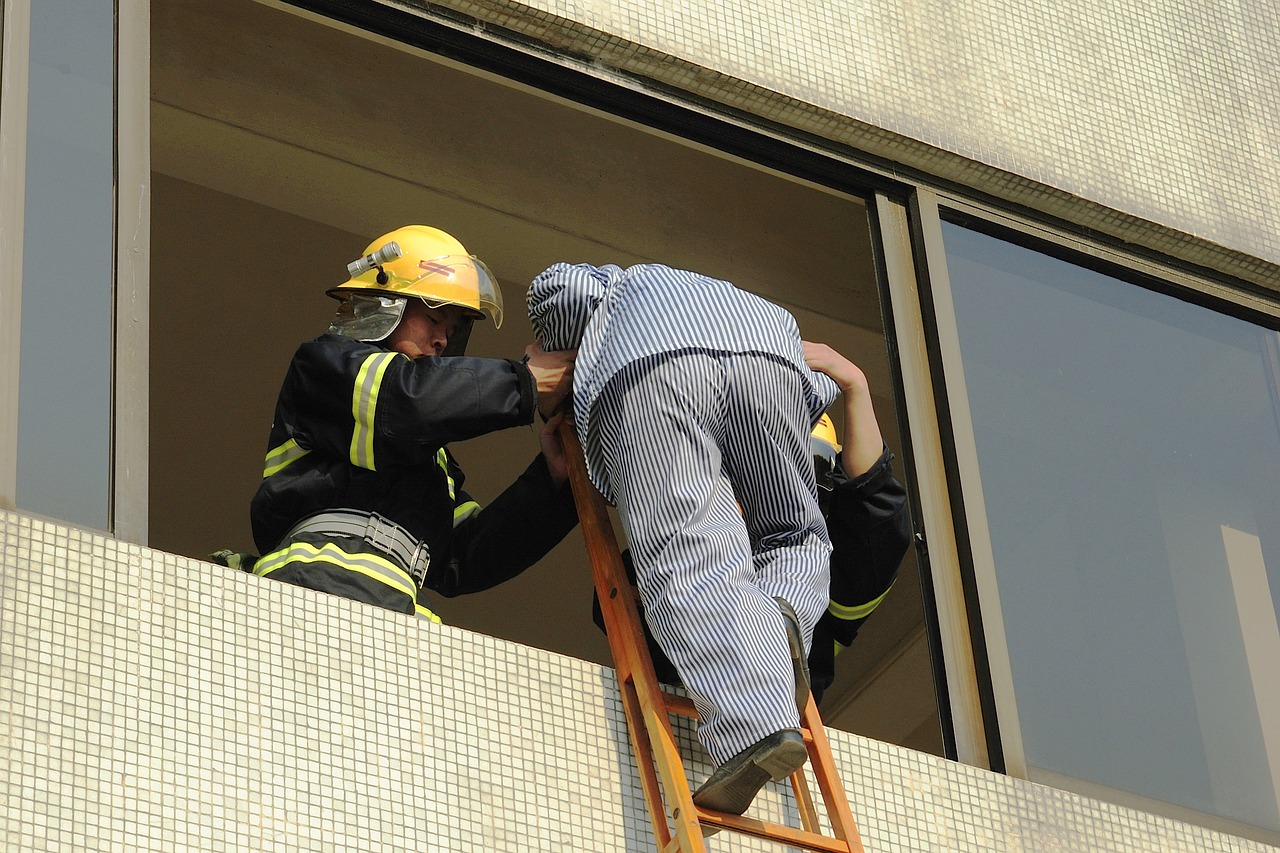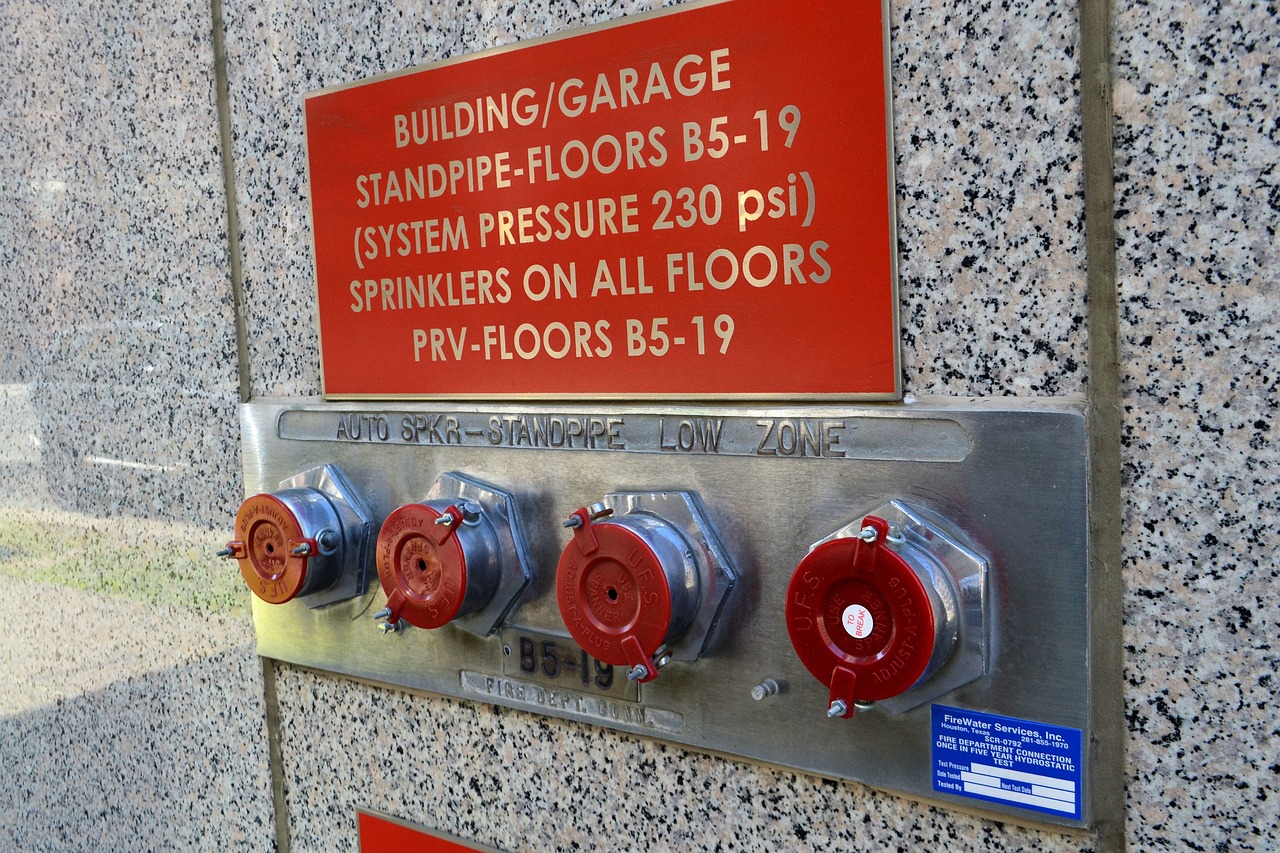Safety Measures and Human Behavior: Can We Draw a Parallel?
In today's world, the connection between safety measures and human behavior is more significant than ever. With the rise of various risks—from health crises to environmental hazards—understanding how these two elements interact can provide valuable insights into societal well-being. Have you ever wondered why some people strictly adhere to safety protocols while others seem to disregard them completely? This article explores the intricate relationship between safety measures and human behavior, examining how they influence each other and the implications for our communities.
To truly grasp the dynamics of safety, we need to delve into the psychological factors that drive human behavior. Our perceptions of risk and the subsequent compliance with safety measures are often shaped by a variety of influences. For instance, when we feel secure in our environment, we may be less inclined to follow safety guidelines. Conversely, heightened awareness of potential dangers can lead to increased compliance. It's almost like a dance; the more confident we feel, the less we adhere to the rules, and when fear creeps in, we become more cautious. This delicate balance is crucial for understanding how to foster safer communities.
How do individuals assess risks and make decisions based on their perceptions? This question is at the core of safety compliance. When faced with a potential danger, our brains perform a quick risk assessment, weighing the likelihood of an event occurring against its potential consequences. This process is influenced by various factors, including personal experiences, cultural background, and social norms. For example, someone who has experienced a car accident may be more vigilant about wearing a seatbelt, while another person who has never faced such an incident might view it as an unnecessary inconvenience.
Our past experiences significantly shape how we perceive risks and safety. When we encounter a negative event, such as a workplace accident or a health scare, it often leaves a lasting impression. This can lead to heightened awareness and compliance with safety measures in similar situations. On the other hand, if an individual has consistently experienced positive outcomes when ignoring safety protocols, they may develop a false sense of security, leading to risky behaviors in the future.
Experiencing trauma can lead to a complex relationship with safety measures. For some, it results in increased compliance and a greater emphasis on following protocols, as they become acutely aware of the potential consequences of negligence. For others, trauma may lead to avoidance behaviors, where individuals distance themselves from reminders of the event, including safety measures. This dichotomy illustrates the profound impact that psychological factors have on our behavior.
On the flip side, positive experiences associated with safety measures can encourage individuals to adopt these behaviors more consistently over time. Imagine a workplace where safety protocols not only prevent accidents but also create a culture of care and concern. Employees who feel valued and protected are more likely to embrace safety measures, leading to a healthier environment for everyone involved.
Social norms and peer influences play a crucial role in shaping individual behaviors towards safety. We are inherently social creatures, often looking to others for cues on how to behave. In group settings, the pressure to conform can either enhance or undermine safety compliance. For instance, if a group of friends decides to skip wearing helmets while cycling, an individual may feel compelled to follow suit, despite knowing the risks involved. This highlights the importance of fostering positive social norms around safety.
Identifying barriers that prevent individuals from following safety measures is essential for designing effective interventions. One significant barrier is the perceived inconvenience of safety protocols. Many people view these measures as cumbersome, leading to non-compliance. For example, wearing a mask might feel uncomfortable, prompting some to forgo it altogether. Addressing these perceptions through user-friendly approaches can enhance adherence.
When safety measures are seen as inconvenient, resistance can build. It's crucial to communicate the benefits clearly and show how these measures can actually make life easier in the long run. For instance, a well-designed safety protocol that integrates seamlessly into daily routines can change perceptions and encourage compliance.
A lack of awareness about the importance of safety measures can hinder compliance. Many individuals may not fully understand the risks they face or the rationale behind certain protocols. This emphasizes the need for effective education and communication strategies that resonate with different populations.
Clear and concise communication is vital in enhancing understanding and compliance with safety measures. Utilizing technology can play a significant role in disseminating safety information. From apps that remind us to wear masks to social media campaigns that raise awareness about safety protocols, technology can make it easier for individuals to stay informed and compliant.
In an age where information is at our fingertips, leveraging technology to spread awareness about safety measures can be transformative. Interactive platforms can engage users in a way that traditional methods cannot. Think about it: a quick notification on your phone about a safety measure can be more effective than a flyer stuck on a wall.
Engaging communities in safety discussions fosters a sense of ownership and responsibility. When individuals feel that they have a stake in their safety, they are more likely to comply with measures. Community meetings, workshops, and social media campaigns can create a culture of safety that resonates with everyone.
- What are the most common barriers to safety compliance? Many individuals cite perceived inconvenience and lack of awareness as significant barriers to following safety measures.
- How can technology improve safety compliance? Technology can disseminate information quickly and effectively, making it easier for individuals to understand and adhere to safety protocols.
- Why do past experiences influence safety behavior? Past experiences shape our risk perceptions, often leading to heightened awareness or avoidance of safety measures based on previous outcomes.

The Psychology of Safety
This article explores the intricate relationship between safety measures and human behavior, examining how they influence each other and the implications for societal well-being.
Understanding the psychology behind safety is like peeling back the layers of an onion; each layer reveals deeper insights into why we behave the way we do when it comes to safety measures. At the core, our instincts drive us to seek safety and avoid danger. This instinct is a fundamental part of our survival mechanism, honed through thousands of years of evolution. However, in today's world, where threats can be both physical and psychological, our responses to safety measures can be quite complex.
Many people often find themselves torn between the desire to adhere to safety protocols and the innate human tendency to take risks. This dichotomy can lead to a range of behaviors, from strict compliance to outright defiance. For instance, think about a crowded concert where safety regulations are in place; some individuals will follow these rules diligently, while others may disregard them entirely, driven by the thrill of the moment. This behavior can be influenced by various psychological factors, including fear, past experiences, and social dynamics.
Moreover, the perception of risk plays a significant role in how individuals respond to safety measures. If someone believes that a particular safety protocol is unnecessary or exaggerated, they are less likely to comply. This belief can stem from personal experiences or from the information they consume through media and social networks. As a result, understanding these perceptions is crucial for designing effective safety measures that resonate with the public.
In addition to personal beliefs, the social environment greatly influences safety behavior. People are often swayed by the actions of their peers. If a person sees their friends disregarding safety protocols, they may feel compelled to do the same, even if they initially intended to comply. This phenomenon highlights the importance of fostering a culture of safety within communities, where positive behaviors are reinforced and celebrated.
Furthermore, the emotional responses associated with safety can’t be overlooked. Feelings of anxiety or complacency can significantly affect compliance. For example, during a health crisis, heightened anxiety may lead individuals to follow safety measures rigorously. Conversely, once the crisis is perceived to be over, complacency may set in, causing individuals to let their guard down. This ebb and flow of emotions underscores the need for ongoing education and communication regarding safety protocols.
Ultimately, the psychology of safety is a multifaceted topic that requires a comprehensive approach. By understanding the underlying psychological factors that drive human behavior, we can create more effective safety measures that not only protect individuals but also foster a culture of compliance and responsibility.
- What is the role of psychology in safety compliance?
The psychology of safety involves understanding how human instincts, perceptions of risk, and social influences affect compliance with safety measures. - How do past experiences influence safety behavior?
Past experiences shape risk perception, leading individuals to either adhere to or avoid safety measures based on previous outcomes. - Can social norms impact individual safety behavior?
Yes, social norms and peer influences can significantly dictate whether individuals choose to comply with safety protocols.

Risk Perception and Decision Making
When it comes to safety, our perception of risk plays a pivotal role in how we make decisions. Imagine walking down a street and seeing a "Wet Floor" sign. Your brain quickly assesses the situation: is the risk of slipping worth the potential reward of walking that path? This mental calculation is not just a reflex; it's a complex interplay of past experiences, societal norms, and personal beliefs. The way we perceive risk can directly influence our adherence to safety protocols. For instance, if someone perceives a low risk of injury from not wearing a helmet while biking, they are less likely to comply with safety measures.
Furthermore, our risk perception is often skewed by emotional responses. Have you ever noticed how a news story about a rare accident can make you feel like the world is a dangerous place? This phenomenon, known as the availability heuristic, causes us to overestimate the likelihood of events that are more memorable or emotionally charged. Consequently, individuals might take unnecessary precautions in some situations while ignoring significant risks in others. For example, after hearing about a shark attack, a person might avoid swimming in the ocean, despite statistically being more likely to be injured in a car accident on the way to the beach.
In decision-making, risk perception can lead to what psychologists call cognitive biases. These biases can distort our judgment and create barriers to effective safety compliance. For instance, some individuals may exhibit a optimism bias, believing that negative events are less likely to happen to them compared to others. This mindset can result in a casual approach towards safety measures, such as skipping seat belts or ignoring fire alarms. On the other hand, some may develop a catastrophic mindset, where they overestimate the dangers and become paralyzed by fear, leading to avoidance behaviors.
To better understand this dynamic, consider the following table that outlines different types of risk perceptions and their potential impact on decision-making:
| Type of Risk Perception | Description | Impact on Decision-Making |
|---|---|---|
| Optimism Bias | Belief that negative events are less likely to happen to oneself | Lower compliance with safety measures |
| Pessimism Bias | Belief that negative events are more likely to happen | Over-compliance or avoidance behavior |
| Availability Heuristic | Overestimation of risks based on memorable events | Inconsistent safety behaviors |
Understanding these biases is crucial for developing effective safety measures. If we can address the underlying perceptions that lead to non-compliance, we can create strategies that resonate with individuals on a personal level. For instance, using relatable stories and real-life examples can help bridge the gap between perception and reality, making safety protocols feel more relevant and necessary.
Ultimately, enhancing our understanding of risk perception and decision-making is not just about changing individual behaviors. It’s about fostering a culture of safety where everyone feels empowered to make informed choices. By acknowledging the psychological factors at play, we can work towards creating an environment where safety measures are not just seen as rules to follow but as essential practices that protect our well-being.
- What is risk perception? Risk perception refers to an individual's assessment of the likelihood and severity of potential hazards.
- How does past experience influence risk perception? Past experiences shape our understanding of risks, often leading to either heightened awareness or desensitization to certain dangers.
- What are cognitive biases? Cognitive biases are systematic patterns of deviation from norm or rationality in judgment, affecting how we perceive risks and make decisions.
- How can we improve compliance with safety measures? Enhancing communication, using relatable examples, and addressing psychological factors can significantly improve compliance rates.

Influence of Past Experiences
When it comes to safety, our past experiences play a pivotal role in shaping how we perceive risks and respond to safety measures. Think about it: if you’ve ever had a close call, like slipping on a wet floor or being in a near-accident while driving, those moments can leave a lasting impression. They act like a mental bookmark, reminding you to be more cautious in similar situations in the future. This phenomenon is often referred to as risk conditioning, where our previous encounters with danger alter our behavior and decision-making processes.
For instance, if someone has experienced a fire in their home, they are likely to develop a heightened sense of awareness regarding fire safety. They might become vigilant about checking smoke detectors or following evacuation protocols. On the flip side, some people may react differently. Instead of becoming more compliant, they might develop an avoidance behavior, steering clear of situations that remind them of their trauma. This dichotomy highlights how personal history can dictate safety compliance.
Moreover, the influence of past experiences is not just confined to personal incidents; it extends to societal narratives as well. For example, communities that have faced natural disasters often adopt stricter safety measures and advocate for preparedness training. They understand the importance of being proactive rather than reactive. This collective memory shapes social norms and can lead to an overall culture of safety within a community.
To illustrate this further, let’s consider a few scenarios:
| Experience Type | Potential Behavior Change |
|---|---|
| Near-accident while driving | Increased adherence to traffic rules and cautious driving |
| Witnessing a workplace accident | Advocating for stricter safety protocols at work |
| Childhood injury from a playground | Avoidance of playgrounds or increased supervision of children |
In summary, our past experiences not only inform our individual behaviors but also shape the safety culture around us. By understanding this connection, we can better tailor safety measures to resonate with people's unique experiences, ultimately leading to improved compliance and a safer environment for everyone. So, the next time you think about safety, consider the powerful influence of what you’ve been through. It’s not just about rules and regulations; it’s about human stories that drive behavior.
- How do past experiences influence safety behavior?
Past experiences can create a heightened sense of awareness or avoidance, affecting how individuals respond to safety measures. - Can community experiences shape safety culture?
Yes, communities that have faced disasters often adopt stricter safety protocols and promote preparedness. - What is risk conditioning?
Risk conditioning refers to the process by which previous encounters with danger influence future behavior and decision-making.

Trauma and Safety Compliance
Trauma can profoundly influence an individual's relationship with safety measures, creating a complex web of behavior that is often driven by fear and heightened awareness. When someone has experienced a traumatic event, their perception of safety can shift dramatically. They may become hyper-vigilant, constantly on the lookout for potential threats, or they might develop an avoidance behavior, steering clear of situations that remind them of their trauma. This duality in response can lead to a fascinating yet challenging dynamic regarding compliance with safety protocols.
For instance, consider someone who has been in a severe car accident. After the incident, they might feel an overwhelming need to adhere strictly to safety measures, such as always wearing a seatbelt or avoiding distractions while driving. This heightened compliance stems from a deep-seated understanding of the risks involved, shaped by their traumatic experience. On the other hand, the same individual could also develop an aversion to driving altogether, fearing that they might encounter another accident. This avoidance can lead to non-compliance with safety measures related to driving, as they simply choose not to engage with the activity at all.
Moreover, the impact of trauma on safety compliance is not limited to personal experiences. It can also extend to societal behaviors. For example, communities that have faced natural disasters or violent incidents often exhibit increased compliance with safety measures in the aftermath. They collectively recognize the importance of preparedness and the need to protect themselves from future harm. This shared understanding can lead to a cultural shift where safety becomes a priority, influencing how individuals behave in relation to safety protocols.
However, it's crucial to note that the relationship between trauma and safety compliance is not uniform. Factors such as social support, access to resources, and individual coping mechanisms play significant roles in determining how trauma affects safety behavior. For instance, individuals with strong social networks may find it easier to adopt safety measures post-trauma, as they receive encouragement and support from their peers. In contrast, those who feel isolated may struggle to comply with safety protocols, as their trauma can lead to feelings of helplessness and despair.
Ultimately, understanding the nuances of how trauma influences safety compliance can help us design more effective interventions. By recognizing that trauma can lead to both increased vigilance and avoidance, we can tailor our safety communications and measures to address these diverse responses. For example, providing resources for trauma-informed care can help individuals process their experiences, fostering a healthier relationship with safety measures. Additionally, community programs that emphasize collective safety can empower individuals to engage with safety protocols, transforming trauma into a catalyst for positive behavioral change.
- How does trauma affect an individual's perception of safety?
Trauma can heighten awareness of potential dangers, leading to either increased compliance with safety measures or avoidance behaviors. - Can community support influence safety compliance after trauma?
Yes, strong social networks can encourage individuals to adopt safety measures by providing support and shared understanding. - What role do past experiences play in safety behavior?
Past experiences shape how individuals assess risks and comply with safety protocols, making them either more vigilant or more fearful.

Positive Reinforcement
When it comes to safety measures, the concept of plays a pivotal role in shaping behavior. Imagine a child learning to look both ways before crossing the street. Each time they do it correctly and safely, they receive praise from their parents. This praise acts as a reward, reinforcing the behavior and making it more likely that the child will repeat it in the future. Similarly, in adult scenarios, when individuals follow safety protocols and receive recognition or tangible rewards for their compliance, they are more inclined to maintain these behaviors over time.
Positive reinforcement can manifest in various forms, and understanding these can help organizations and communities foster a culture of safety. Here are some common types of positive reinforcement that can be effectively utilized:
- Verbal Praise: Simple acknowledgments can go a long way. A shout-out in a meeting or a thank-you note can make individuals feel valued.
- Incentives: Offering rewards such as gift cards or extra time off for consistent safety compliance can motivate individuals to adhere to safety measures.
- Public Recognition: Highlighting individuals or teams who exemplify safety practices can inspire others to follow suit.
Moreover, the impact of positive reinforcement extends beyond individual behavior; it can create a ripple effect within organizations and communities. When people see their peers being rewarded for safe practices, they are likely to emulate those behaviors, leading to a collective improvement in safety compliance. This is akin to a domino effect, where one person's positive action encourages another, creating a safer environment for everyone.
However, it's essential to tailor positive reinforcement strategies to suit the specific audience. What works for one group may not resonate with another. For instance, younger employees might respond better to gamified safety training sessions with rewards, while seasoned professionals might appreciate more formal recognition. Understanding the audience's preferences can significantly enhance the effectiveness of these strategies.
In conclusion, leveraging positive reinforcement is not merely about rewarding good behavior; it’s about creating an environment where safety becomes a shared value. By continually recognizing and rewarding compliance, we can foster a culture that prioritizes safety, ultimately leading to a more secure society. So, the next time you witness someone adhering to safety measures, consider giving them a nod of appreciation—it might just encourage them to keep it up!
- What is positive reinforcement? Positive reinforcement is a behavioral principle where rewarding desired behaviors increases the likelihood of those behaviors being repeated.
- How can positive reinforcement improve safety compliance? By recognizing and rewarding individuals for following safety measures, it encourages them and others to adopt similar behaviors.
- What are some examples of positive reinforcement in the workplace? Examples include verbal praise, incentives like bonuses, and public recognition for maintaining safety standards.
- Can positive reinforcement work in community safety initiatives? Absolutely! Community programs that reward safe behaviors can motivate more individuals to participate and adhere to safety guidelines.

Social Influences on Safety Behavior
When it comes to safety behavior, the impact of social influences cannot be underestimated. Humans are inherently social creatures, and our actions often reflect the norms and expectations of the groups we belong to. Think about it: have you ever noticed how your friends' behaviors can sway your own choices, especially when it comes to safety? Whether it's wearing a seatbelt, adhering to health guidelines, or following safety protocols at work, our compliance is frequently dictated by those around us.
Social norms play a crucial role in shaping our perceptions of what is acceptable behavior. If everyone around you is wearing a helmet while biking, you're more likely to do the same. Conversely, if you find yourself in a group that dismisses safety measures, you might feel pressured to conform, even if you know better. This phenomenon is known as peer influence, and it can lead to both positive and negative outcomes. In a workplace setting, for instance, if safety is prioritized by management and embraced by employees, it creates a culture of compliance that benefits everyone.
Moreover, the role of social proof cannot be overlooked. When individuals observe others engaging in safe practices, they are more likely to adopt similar behaviors. This is particularly effective in community settings where safety behaviors can be modeled and reinforced. For example, if a community organizes regular safety drills, participation can foster a sense of collective responsibility, making safety a shared value. In this way, social influences act as a powerful catalyst for promoting safety behaviors.
However, it’s essential to recognize that these influences can also create barriers. In some cases, individuals may feel that their safety concerns are trivialized by their peers, leading to a reluctance to voice their opinions. This is where effective communication becomes critical. By fostering an environment where safety discussions are encouraged, individuals can feel empowered to advocate for their own safety as well as that of others. Creating platforms for open dialogue can help to break down barriers and build a community that prioritizes safety.
In summary, the dynamics of social influences on safety behavior are complex and multifaceted. They can either promote compliance or contribute to non-compliance, depending on the context and the prevailing norms within a group. Understanding these social dynamics is essential for developing effective safety programs and interventions. By leveraging the power of social influence, we can create environments where safety is not just a personal responsibility but a collective commitment.
- What are social norms? Social norms are the unwritten rules that govern behavior in groups and societies. They dictate what is considered acceptable or unacceptable behavior.
- How can peer influence affect safety behavior? Peer influence can lead individuals to adopt behaviors that align with those of their peers, whether positive or negative. This can significantly impact compliance with safety measures.
- What role does communication play in safety behavior? Effective communication fosters an environment where individuals feel comfortable discussing safety concerns, which can enhance compliance and encourage collective responsibility.

Barriers to Safety Compliance
When we think about safety compliance, it’s easy to assume that everyone understands its importance. However, the reality is often much more complex. There are numerous barriers that can prevent individuals from adhering to safety measures, and understanding these barriers is crucial for improving compliance rates. One major barrier is the perception of inconvenience. Many people view safety protocols as an added burden rather than a necessary precaution. For instance, wearing a helmet while riding a bike may feel cumbersome, leading some to skip this safety measure altogether. This perception can be particularly pronounced in environments where safety measures are perceived as time-consuming or disruptive to routine activities.
Another significant barrier is the lack of awareness regarding the importance of safety measures. Many individuals simply do not understand the risks associated with non-compliance. This lack of awareness can stem from insufficient education or communication about safety protocols. For example, a worker in a manufacturing plant may not fully grasp the dangers of not wearing protective gear, leading to a higher likelihood of accidents. To combat this, effective education and communication strategies are essential. These strategies should aim to not only inform individuals about the risks but also empower them to take ownership of their safety.
Moreover, social influences can also create barriers to safety compliance. In group settings, peer pressure can lead individuals to disregard safety measures, especially if they perceive that their peers are not following them. This phenomenon can be particularly evident in high-risk environments, such as construction sites or during recreational activities. When safety becomes a matter of social norms, individuals might prioritize acceptance over safety, which can have dire consequences.
It's also important to consider the role of psychological factors in safety compliance. For instance, individuals who have previously experienced trauma may have heightened awareness of safety measures, but this can lead to either increased compliance or avoidance behaviors. While some may become overly cautious, others might react by dismissing safety measures altogether, believing they are invulnerable. This complex relationship between past experiences and current behavior highlights the need for tailored interventions that consider individual psychological backgrounds.
To effectively address these barriers, organizations and communities must develop a multifaceted approach. This could include:
- Creating user-friendly safety protocols that minimize inconvenience.
- Implementing educational programs that raise awareness about the importance of safety.
- Encouraging positive social norms that promote safety compliance among peers.
By identifying and addressing these barriers, we can foster a culture of safety that encourages individuals to prioritize their well-being and the well-being of those around them. In conclusion, understanding the obstacles to safety compliance is the first step in creating effective strategies that enhance adherence to safety measures. This understanding not only protects individuals but also contributes to the overall safety and health of our communities.
Q: What are the most common barriers to safety compliance?
A: The most common barriers include perceived inconvenience, lack of awareness, social influences, and psychological factors stemming from past experiences.
Q: How can organizations improve safety compliance?
A: Organizations can improve safety compliance by simplifying safety protocols, providing education and training, and fostering a positive safety culture among employees.
Q: Why is awareness important for safety compliance?
A: Awareness is crucial because it helps individuals understand the risks associated with non-compliance and encourages them to take proactive steps to protect themselves and others.

Perceived Inconvenience
When we think about safety measures, one of the biggest hurdles that often pops up is the associated with them. Have you ever found yourself rolling your eyes at the thought of putting on a seatbelt or wearing a helmet while biking? It’s easy to dismiss these precautions as just another hassle in our busy lives. This perception can significantly impact our willingness to comply with safety protocols. In fact, many individuals see safety measures as an added burden rather than a protective shield, which can lead to non-compliance.
To illustrate this point, consider a typical day at work. Imagine a scenario where employees are required to wear safety goggles in a manufacturing facility. While the intention is to protect their eyes from potential hazards, many workers might view the goggles as uncomfortable or cumbersome. This discomfort can lead to a lack of adherence to the safety rule, ultimately increasing the risk of injury. It’s a classic case of how our minds can trick us into prioritizing short-term comfort over long-term safety.
Moreover, the perception of inconvenience can vary among different demographics. For instance, younger individuals may prioritize social acceptance over safety, viewing certain measures as "uncool." On the other hand, older adults might have a more cautious approach, yet still find certain safety protocols to be bothersome. This discrepancy highlights the need for tailored approaches when implementing safety measures. Understanding the target audience's mindset can help in designing interventions that are not only effective but also considerate of their preferences.
One effective strategy to combat the perception of inconvenience is to streamline safety procedures. By making safety measures more user-friendly, organizations can encourage compliance. For example, instead of requiring cumbersome protective gear, companies might invest in lighter, more comfortable alternatives that still provide adequate protection. This way, individuals are less likely to view safety as an inconvenience and more as a natural part of their routine.
In summary, addressing the perceived inconvenience of safety measures is crucial for enhancing compliance. By recognizing and mitigating these perceptions, we can foster a culture of safety that emphasizes protection without sacrificing comfort. After all, when safety feels less like a chore and more like a seamless part of our lives, we are more likely to embrace it wholeheartedly.
- Why do people often resist safety measures?
Many individuals view safety measures as inconvenient or unnecessary, leading to resistance. - How can organizations improve compliance with safety protocols?
By making safety measures more user-friendly and addressing perceived inconveniences. - What role does education play in safety compliance?
Effective education can raise awareness about the importance of safety measures, countering misconceptions. - Can technology help in promoting safety compliance?
Yes, technology can facilitate the dissemination of safety information and reminders, making it easier for individuals to stay informed.

Lack of Awareness
The issue of surrounding safety measures is a significant barrier to compliance that often goes unnoticed. Many individuals simply do not understand the importance of safety protocols, which can lead to dangerous situations. Imagine driving without ever having learned about seat belts or traffic signals; the potential for harm is immense. This lack of understanding can stem from various factors, including inadequate education, insufficient communication from authorities, or even cultural beliefs that downplay the importance of safety.
Consider the workplace environment, where safety measures are crucial. If employees are unaware of the risks associated with their tasks or the safety equipment available to them, they are less likely to engage in safe practices. This can result in higher accident rates and a culture of negligence. To illustrate this, let’s look at a simple table that breaks down the reasons for lack of awareness:
| Reason | Description |
|---|---|
| Inadequate Training | Employees may not receive proper training on safety protocols, leading to ignorance about necessary precautions. |
| Poor Communication | Information about safety measures may not be effectively communicated, leaving individuals uninformed. |
| Cultural Beliefs | Some cultures may not prioritize safety, viewing it as unnecessary or overly cautious. |
Furthermore, the role of technology in enhancing awareness cannot be overstated. In our digital age, utilizing platforms like social media, apps, and websites can significantly improve the dissemination of safety information. For instance, organizations can create engaging content that highlights the importance of safety measures, making it relatable and easier to understand. This approach not only informs individuals but also encourages them to take action.
Another critical aspect is the need for community engagement. When communities come together to discuss safety, it fosters a sense of shared responsibility. People are more likely to pay attention to safety measures when they see their peers actively participating in discussions and initiatives. This collective awareness can lead to a culture where safety is prioritized, and individuals feel empowered to adhere to safety protocols.
In conclusion, addressing the lack of awareness surrounding safety measures requires a multifaceted approach. From improving education and communication to leveraging technology and community engagement, there are numerous strategies that can be employed. By fostering a culture of awareness, we can significantly enhance compliance with safety measures, ultimately leading to a safer society for everyone.
- What are some common safety measures people overlook? Many individuals overlook basic safety measures such as wearing seat belts, using helmets while biking, and following fire safety protocols.
- How can technology improve safety awareness? Technology can disseminate information quickly and effectively through apps, social media, and online training modules, making safety protocols more accessible.
- What role does community play in safety compliance? Community engagement fosters a sense of responsibility and accountability, encouraging individuals to adhere to safety measures collectively.

Effective Communication of Safety Measures
When it comes to safety, effective communication is not just important; it's essential. Imagine trying to navigate a busy street without any traffic signals or signs. You'd feel lost and anxious, right? The same principle applies to safety measures in various environments, whether at work, school, or in public spaces. Without clear communication, individuals may not understand the importance of these measures, leading to a lack of compliance and increased risk. So, how can we ensure that safety messages are communicated effectively?
First and foremost, clarity is key. Safety messages should be simple and straightforward. Using technical jargon or complex language can confuse people and make them less likely to follow the guidelines. For instance, instead of saying "utilize personal protective equipment," it’s more effective to simply say "wear your safety gear." This approach ensures that everyone, regardless of their background or education level, can grasp the message without feeling overwhelmed.
Moreover, visual aids can significantly enhance understanding and retention of safety information. Infographics, posters, and videos can convey messages more effectively than text alone. For example, a well-designed infographic illustrating the steps to take in case of a fire can be much more impactful than a lengthy manual. People are naturally drawn to visuals, and they often remember images better than words. Therefore, incorporating visual elements into safety communications can lead to better compliance.
In addition to clarity and visuals, the timing of communication plays a pivotal role. Safety measures should be communicated proactively, rather than reactively. For instance, instead of waiting for a safety incident to occur, organizations should regularly remind employees or community members about safety protocols. This can be done through monthly safety meetings, newsletters, or digital alerts. By keeping safety at the forefront of people's minds, they are more likely to internalize these measures and act accordingly.
Furthermore, utilizing technology can significantly enhance the dissemination of safety information. Mobile apps, social media platforms, and websites can serve as effective channels for communicating safety measures. For example, a workplace might use an app that sends push notifications about safety drills or updates on safety protocols. This not only keeps everyone informed but also encourages a culture of safety where individuals feel empowered to engage with the information actively.
Community engagement is another powerful tool for effective communication. When individuals feel like they are part of the safety conversation, they are more likely to take ownership of their behaviors. Organizing community workshops or safety fairs can foster discussions about safety measures and allow individuals to voice their concerns and suggestions. This two-way communication not only builds trust but also enhances compliance as people feel their opinions are valued.
To summarize, effective communication of safety measures hinges on clarity, visual aids, timely reminders, technological engagement, and community involvement. By focusing on these elements, we can create an environment where safety is prioritized, understood, and embraced by all. After all, safety is a shared responsibility, and when we communicate effectively, we pave the way for a safer society.
- Why is effective communication important for safety measures? Effective communication ensures that safety protocols are understood, leading to better compliance and reduced risk of accidents.
- How can visuals enhance safety communication? Visual aids make safety messages more memorable and easier to understand, allowing individuals to grasp the information quickly.
- What role does technology play in safety communication? Technology can disseminate safety information quickly and efficiently, keeping individuals informed and engaged.
- How can community engagement improve safety compliance? Involving the community in safety discussions fosters a sense of ownership and responsibility, leading to better adherence to safety measures.

Utilizing Technology for Awareness
This article explores the intricate relationship between safety measures and human behavior, examining how they influence each other and the implications for societal well-being.
Understanding the psychological factors that drive human behavior in relation to safety measures can provide insights into compliance and risk perception in various environments.
This section delves into how individuals assess risks and make decisions based on their perceptions, impacting their adherence to safety protocols.
Past experiences significantly shape how people perceive risks and safety, affecting their behavior in similar situations in the future.
Experiencing trauma can lead to heightened awareness of safety measures, resulting in either increased compliance or avoidance behaviors.
Positive experiences associated with safety measures can encourage individuals to adopt these behaviors more consistently over time.
Social norms and peer influences play a crucial role in shaping individual behaviors towards safety, often dictating compliance levels in group settings.
Identifying barriers that prevent individuals from following safety measures can help in designing effective interventions and promoting better adherence.
Many individuals view safety measures as inconvenient, which can lead to non-compliance, highlighting the need for more user-friendly approaches.
A lack of awareness about the importance of safety measures can hinder compliance, emphasizing the need for effective education and communication strategies.
Exploring how clear and concise communication can enhance understanding and compliance with safety measures among different populations.
In today's fast-paced world, technology serves as a powerful ally in promoting safety awareness. Imagine a world where information travels at the speed of light, reaching individuals before they even realize they need it. This is the essence of leveraging technology for safety awareness. From mobile applications to social media platforms, the tools at our disposal can transform how we communicate vital safety information.
For instance, mobile apps can send real-time alerts about safety measures, be it for natural disasters, health protocols, or safety regulations in public spaces. These apps not only keep users informed but can also remind them of necessary precautions. Furthermore, social media campaigns can engage a broader audience, utilizing eye-catching graphics and relatable content to drive home the importance of adhering to safety protocols.
Here are a few ways technology can enhance safety awareness:
- Real-Time Notifications: Instant alerts can inform individuals of emerging risks or necessary safety measures.
- Interactive Learning: Online platforms can offer engaging training modules that educate users on safety practices.
- Community Forums: Social media can facilitate discussions around safety, allowing individuals to share experiences and advice.
Moreover, the integration of technology into safety practices doesn't stop with information dissemination. Data analytics can help organizations identify trends in safety compliance and areas needing improvement. For example, analyzing user engagement with safety apps can reveal which features are most effective, guiding future enhancements.
Ultimately, utilizing technology for safety awareness is not just about keeping people informed; it's about fostering a culture where safety is prioritized. When individuals feel empowered with knowledge and resources, they are more likely to take proactive measures to protect themselves and their communities. In this digital age, we have the tools to make safety a shared responsibility, transforming it from a mere obligation into a collective commitment.
- How can technology improve safety awareness?
Technology can provide real-time updates, interactive learning tools, and facilitate community discussions, enhancing overall awareness and compliance.
- What role does social media play in promoting safety?
Social media can spread information quickly and engage users through relatable content, making safety measures more accessible and understandable.
- Are there specific apps for safety awareness?
Yes, there are numerous apps designed for various safety needs, including emergency alerts, health protocols, and community safety resources.

Community Engagement Strategies
Community engagement is a vital component in promoting safety measures effectively among various populations. When individuals feel a sense of ownership and responsibility towards their community, they are more likely to adhere to safety protocols. One of the most impactful strategies involves fostering open dialogues where community members can express their concerns, share experiences, and collaborate on solutions. This creates a supportive environment that encourages compliance with safety measures.
Another effective strategy is to leverage local leaders and influencers within the community. These individuals often have the trust and respect of their peers, making them ideal advocates for safety initiatives. By involving them in safety campaigns, communities can amplify their messages and reach wider audiences. For example, local sports figures, teachers, and business owners can host events or workshops that highlight the importance of safety measures, thereby creating a ripple effect of awareness and compliance.
Additionally, utilizing technology can significantly enhance community engagement. Social media platforms, community apps, and websites can serve as powerful tools for disseminating information about safety measures. By creating interactive content, such as quizzes or challenges about safety practices, communities can engage members in a fun and informative way. This not only educates but also fosters a sense of camaraderie among participants, as they work together to improve community safety.
Moreover, organizing community events, such as safety fairs or workshops, can provide hands-on experiences that reinforce the importance of safety measures. These events can include demonstrations, informative talks, and even fun activities that teach safety protocols in an engaging manner. For instance, a local fire department might conduct a fire safety demonstration, allowing community members to learn and practice safety techniques in a controlled environment. Such initiatives can create lasting impressions and motivate individuals to prioritize safety in their daily lives.
In summary, community engagement strategies are essential for enhancing compliance with safety measures. By fostering open communication, leveraging local influencers, utilizing technology, and organizing engaging events, communities can cultivate a culture of safety. This not only improves adherence to safety protocols but also strengthens the community as a whole, making it a safer place for everyone.
- What are community engagement strategies?
Community engagement strategies are approaches that involve the active participation of community members in discussions and initiatives aimed at improving safety and well-being within their environment. - How can local leaders influence safety compliance?
Local leaders can influence safety compliance by advocating for safety measures, hosting educational events, and serving as role models for positive behavior within the community. - Why is technology important in community engagement?
Technology is important because it allows for the efficient dissemination of information, facilitates communication, and encourages interactive participation among community members. - What types of events can promote safety awareness?
Events like safety fairs, workshops, and demonstrations can effectively promote safety awareness by providing hands-on experiences and educational opportunities for community members.
Frequently Asked Questions
- What are the psychological factors that influence safety compliance?
Psychological factors such as risk perception, past experiences, and social influences play a significant role in how individuals comply with safety measures. For instance, someone who has faced a traumatic incident may become more vigilant about safety protocols, while others may be influenced by their peers' attitudes towards safety.
- How does past experience shape our behavior towards safety?
Past experiences can profoundly affect our perception of risks. If someone has encountered a dangerous situation before, they are likely to be more cautious in similar scenarios. This heightened awareness can lead to either increased compliance with safety measures or, conversely, avoidance behaviors if they associate safety with negative feelings.
- What barriers prevent people from following safety measures?
Several barriers can hinder compliance with safety measures, including perceived inconvenience and lack of awareness. Many individuals view safety protocols as cumbersome, which can deter them from adhering to them. Additionally, if people are not fully aware of the importance of these measures, they are less likely to follow them.
- How can effective communication enhance safety compliance?
Clear and concise communication is crucial in promoting understanding and adherence to safety measures. By utilizing straightforward language and engaging visuals, organizations can ensure that individuals grasp the importance of safety protocols, leading to better compliance rates.
- What role does technology play in promoting safety awareness?
Technology can significantly enhance safety awareness by providing easy access to information and updates. Apps, social media platforms, and websites can disseminate safety guidelines rapidly, keeping individuals informed and engaged with the necessary protocols.
- How can community engagement improve safety behaviors?
Engaging communities in discussions about safety fosters a sense of ownership and responsibility. When individuals feel involved in the conversation, they are more likely to adopt safety measures and encourage others to do the same, leading to a collective improvement in safety behaviors.



















